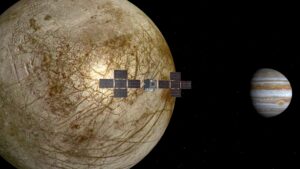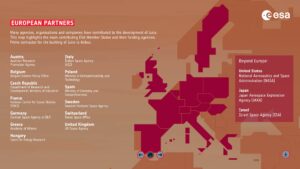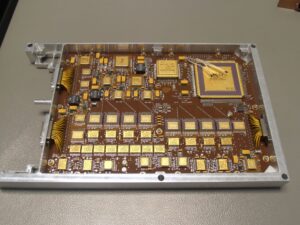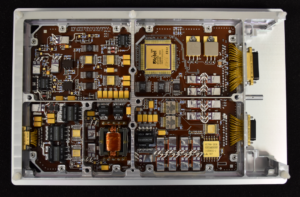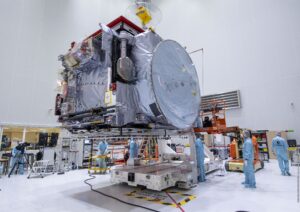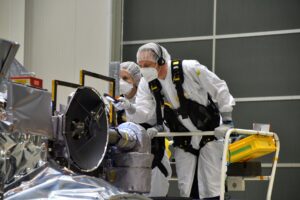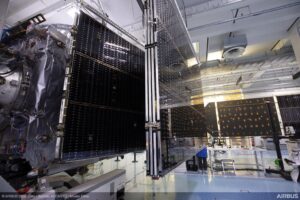European mission JUICE to Jupiter with Czech participation is ready for launch
The ESA’s (European Space Agency) JUICE (Jupiter Icy Moons Explorer) mission, with important participation of Czech scientists and businesses, is scheduled to launch on 13th April 2023.
The spacecraft will be launched from the Europe´s Spaceport in French Guiana on an Ariane 5 rocket. Participation in JUICE is after participation in the Solar Orbiter mission another important Czech involvement in a large international space science project. Projects and contracts worth of CZK 160 million (EUR 6,55 million) have been implemented in the Czech Republic. These projects and contracts were funded by the contribution of the Ministry of Education, Youth and Sports (MEYS) to the ESA’s Science Programme and the PRODEX programme.
“The Czech participation in the JUICE mission confirms that the Czech Republic has a strong place in the European cooperation in space research. Of the projects in which the Czech Republic has participated so far, also by supplying hardware, the JUICE mission will fly the farthest ever, which means huge demands on the quality of the supplied components, which must function flawlessly in the inhospitable environment of space and high radiation in the vicinity of Jupiter for many years without any possibility of repair”, comments the importance of the event Prof. Radka Wildová, Director General for Higher Education, Science and Research at the Ministry of Education, Youth and Sports.
(Pic.: Juice flyby of Europa; source: ESA)
JUICE is the first of large, „flagship“ missions of ESA´s Science Programme. JUICE will make detailed observations of the giant gaseous planet Jupiter and its three largest moons, Ganymede, Callisto and Europa, which are thought to harbour oceans and possibly life. After its launch, a series of gravity-assist flybys of Earth and Venus will help JUICE to reach the largest planet in our Solar System. JUICE will arrive at Jupiter in 2031 and in 2034, it will become the first spacecraft to orbit a moon other than Earth’s.
(Pic.: European partners of JUICE, source: ESA)
Participation in the development of scientific payload
Two teams of Czech scientists from the Institute of Atmospheric Physics of the Czech Academy of Sciences and the Astronomical Institute of the Czech Academy of Sciences were involved in the large international collaboration working on the design and development of one of the scientific instruments of the JUICE mission, the Radio and Plasma Wave Investigation (RPWI). The main task of this instrument is to determine the parameters needed to analyse the generation and propagation of electromagnetic waves in the plasma inside the magnetosphere of Jupiter, in the vicinity of its icy moons and in the magnetosphere of the moon Ganymede.
Team from the Institute of Atmospheric Physics of the Czech Academy of Sciences (IAP) designed and developed a multi-component electromagnetic wave analyser for the RPWI instrument and managed to get directly to the highest management structure of the RPWI instrument. The team participated in its design, collaborated in the planning of scientific measurements and is preparing for data analysis. Scientists from the IAP are also involved in the scientific working groups of the mission, in which they participate in the preparation of scientific measurements, focusing on electromagnetic detection of discharges in the atmosphere of Jupiter, and especially on electromagnetic radiation in the magnetosphere of the planet, and in the preparation of research on its moons, especially the moon Ganymede.
(Pic.: Electromagnetic wave analyser developed at the Institute of Atmospheric Physics of the Czech Academy of Sciences)
The engineering team from the Astronomical Institute of the Czech Academy of Sciences (ASI) provided for the RPWI instrument a pair of specially designed power supplies with extremely low noise. The scientists from ASI intend to use the direct access to the measured data from the JUICE mission primarily for comparison with their own numerical model describing the effect of the moons of Jupiter (Ganymede, Europa, Callisto) on its large magnetosphere. The findings will then be used, for example, to deepen knowledge of the geological properties and structure of Jupiter’s moons themselves.
(Pic.: Low voltage power supply of the RPWI instrument developed at the Astronomical Institute of the Czech Academy of Sciences)
Contracts of Czech companies
In addition to the above research organisations, a number of Czech companies were involved in the development and production of components for the RPWI instrument. For the electromagnetic wave analyser developed by the scientists from IAP, the G.L. Electronic company provided qualified fitting of electronic components, including relevant quality tests; the Pragoboard and Gatema PCB companies produced printed circuit boards for the same instrument according to the designs of the scientists from IAP. The Czech Aerospace Research Centre provided quality control and quality management for the development and testing of the RPWI power supply developed at ASI, for which G.L. Electronic also provided qualified modifications of the tuning components.
(Pic.: Juice unpacking at Europe’s Spaceport in French Guiana, source: ESA)
Czech companies also participated in the development of the spacecraft itself. The BD Sensors-CSRC Space Division company supplied the electronic unit for the antenna, which will ensure communication between the JUICE probe and the Earth, and the G.L. Electronic company supplied the cable harnesses. Also, Frentech Aerospace has supplied mechanisms for the J-MAG magnetometer instrument arm, the Nav Cam navigation camera and the mechanism for the RIME subsurface radar antenna. Experts from the Institute of Scientific Instruments of the Czech Academy of Sciences tested the thermal emissivity of the coating of JUICE spacecraft. Other deliveries were made by 5M and SERENUM.
(Pic.: Juice medium-gain antenna, developed in cooperation with Czech companies; source: ESA)
ESA is an international organisation dedicated to cooperation in space research and development and applications of space technology. The MEYS’s contribution to ESA’s R&D programmes will reach EUR 14.2 million EUR in 2023. The total Czech contribution to ESA, including that of the Ministry of Transport, will reach EUR 61.8 million in 2023.
(Pic.: Juice solar array deployment test, source: ESA)
